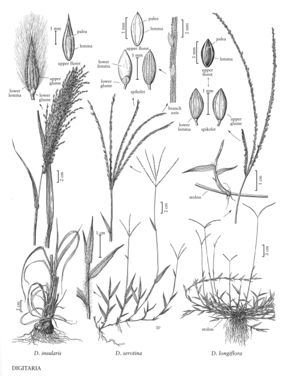Digitaria longiflora
Plants of indefinite duration; stoloniferous, stolons long and branching. Culms 10-60 cm, occasionally branching from the lower nodes. Leaves 3-4, clustered near the base; sheaths usually glabrous; ligules 0.5-1 mm; blades 1.5-4 cm long, 3-5 mm wide, mostly glabrous, bases subcordate and ciliate, with 0.6-1 mm papillose-based hairs. Panicles with 2(-4) spikelike primary branches, digitate; primary branches 2-5 cm, strongly divergent; branch axes about 1 mm wide, wing-margined, wings wider than the central midribs, bearing spikelets in unequally pedicellate groups of 3; secondary branches rarely present; shortest pedicels about 0.3 mm; middle pedicels about 1 mm; longest pedicels 1.5-2 mm, adnate to the branch axes basally; axillary panicles not present. Spikelets 1.2-1.5 mm, elliptic or slightly obovate, acute. Lower glumes absent; upper glumes equaling or almost equaling the spikelets, 5-veined, minutely pubescent between the veins and on the margins; lower lemmas subequal to the upper glumes, 7-veined, usually pubescent on the margins and lateral veins, occasionally glabrous, hairs, if present, 0.2-0.4 mm; upper lemmas about 1.2 mm, pale brown or pale gray, becoming light brown at maturity, acute; anthers 0.8-0.8 mm. 2n = 18.
Distribution
Puerto Rico, Md., Fla., Wis.
Discussion
Digitaria longiflora is native to Africa and Asia. It is now established in disturbed areas of Florida, growing on railroad grades and in pastures and lawns.
Selected References
None.
